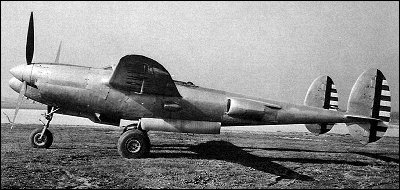 |
Lockheed XP-491942 |  |
| FIGHTER | Virtual Aircraft Museum / USA / Lockheed |
 |
The Lockheed XP-49, its designation seemingly out of sequence in that it was a conception of pre-war years, was designed in 1939 with the ambitious goal of attaining 761km/h in level flight at 4572m. The XP-49 would have been a veritable flying arsenal in its day as it was to be armed with two 20mm cannon and four 12.7mm machine-guns. It was rigorously and exhaustively tested at Burbank, California, and Wright Field, Ohio, and the XP-49 was denied production status because of an engine substitution and the appearance of the Thunderbolt and Mustang. The XP-49 was an outgrowth of the P-38 Lightning but in most respects was an entirely new design by the Lockheed-Burbank fighter team under H. L. Hibbard and Clarence (Kelly) Johnson. Ordered by the US Army on 3 August 1939 to meet a twin-engine fighter requirement (which also produced the Grumman XP-50) the sole XP-49 was expected to attain unprecedented performance by mating the Lightning's familiar twin-boom layout with two 1715kW Pratt & Whitney X-1800 24-cylinder inline engines. When plans to develop the powerplant proved too ambitious, twin 1006kW Continental XIV-1430-1 engines had to be substituted, reducing speed to a still-impressive 737km/h, although this was reached because the test ship lacked the added weight of protective armour which would have been fitted on a production variant. "We still felt we had a winner," says a Lockheed engineer. "We had a roomy, pressurised cabin, good handling characteristics and, eventually, good manoeuvrability." US Army planners saw the XP-49 as a possible 'convoy fighter' able to escort bombers on deep penetration raids. It might have been accorded higher priority had England been lost as a base from which to mount the air assault on the Third Reich. The XP-49 first flew 11 November 1942 at Burbank. When it became necessary to increase the vertical fin area to improve yaw characteristics, the result was an unusual set of markings: Army directives called for 13 alternating red and white horizontal stripes on the rudder, symbolic of the original 13 American colonies. When the tail was heightened, painters simply added non-regulation extra stripes. At Burbank, the XP-49 survived a crash-landing caused by hydraulic failure, was repaired, and was ferried to Wright Field, Ohio, on 25 June 1943. Though it was a clear improvement over the P-38, able to "fly rings around the Lightning" in the words of one pilot, minor but troublesome fuel leakage problems led to XP-49 tests being discontinued and the airframe being scrapped, just when Mustangs with long-range drop tanks were appearing over Berlin. The 'convoy fighter' concept was studied later with the Lockheed XP-58 but never produced an operational aircraft.
|  COMPANY PROFILE | ||||||||||||||||||||||||||||||||||||||||||||||||||||||||||||
 |

|

